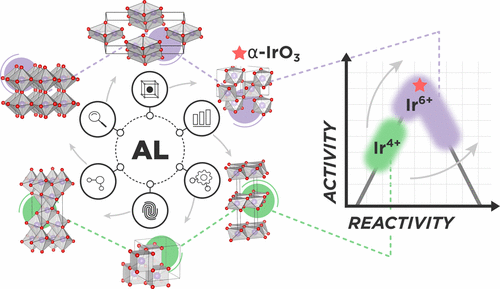当前位置:
X-MOL 学术
›
Chem. Mater.
›
论文详情
Our official English website, www.x-mol.net, welcomes your
feedback! (Note: you will need to create a separate account there.)
Active Learning Accelerated Discovery of Stable Iridium Oxide Polymorphs for the Oxygen Evolution Reaction
Chemistry of Materials ( IF 7.2 ) Pub Date : 2020-06-18 , DOI: 10.1021/acs.chemmater.0c01894 Raul A. Flores 1, 2 , Christopher Paolucci 1, 2, 3 , Kirsten T. Winther 1, 2 , Ankit Jain 1, 2, 4 , Jose Antonio Garrido Torres 1, 2 , Muratahan Aykol 5 , Joseph Montoya 5 , Jens K. Nørskov 6 , Michal Bajdich 2 , Thomas Bligaard 2, 7
Chemistry of Materials ( IF 7.2 ) Pub Date : 2020-06-18 , DOI: 10.1021/acs.chemmater.0c01894 Raul A. Flores 1, 2 , Christopher Paolucci 1, 2, 3 , Kirsten T. Winther 1, 2 , Ankit Jain 1, 2, 4 , Jose Antonio Garrido Torres 1, 2 , Muratahan Aykol 5 , Joseph Montoya 5 , Jens K. Nørskov 6 , Michal Bajdich 2 , Thomas Bligaard 2, 7
Affiliation

|
The discovery of high-performing and stable materials for sustainable energy applications is a pressing goal in catalysis and materials science. Understanding the relationship between a material’s structure and functionality is an important step in the process, such that viable polymorphs for a given chemical composition need to be identified. Machine-learning-based surrogate models have the potential to accelerate the search for polymorphs that target specific applications. Herein, we report a readily generalizable active-learning (AL) accelerated algorithm for identification of electrochemically stable iridium oxide polymorphs of IrO2 and IrO3. The search is coupled to a subsequent analysis of the electrochemical stability of the discovered structures for the acidic oxygen evolution reaction (OER). Structural candidates are generated by identifying all 956 structurally unique AB2 and AB3 prototypes in existing materials databases (more than 38000). Next, using an active learning approach, we find 196 IrO2 polymorphs within the thermodynamic amorphous synthesizability limit and reaffirm the global stability of the rutile structure. We find 75 synthesizable IrO3 polymorphs and report a previously unknown FeF3-type structure as the most stable, termed α-IrO3. To test the algorithms performance, we compare to a random search of the candidate space and report at least a 2-fold increase in the rate of discovery. Additionally, the AL approach can acquire the most stable polymorphs of IrO2 and IrO3 with fewer than 30 density functional theory optimizations. Analysis of the structural properties of the discovered polymorphs reveals that octahedral local coordination environments are preferred for nearly all low-energy structures. Subsequent Pourbaix Ir–H2O analysis shows that α-IrO3 is the globally stable solid phase under acidic OER conditions and supersedes the stability of rutile IrO2. Calculation of theoretical OER surface activities reveal ideal weaker binding of the OER intermediates on α-IrO3 than on any other considered iridium oxide. We emphasize that the proposed AL algorithm can be easily generalized to search for any binary metal oxide structure with a defined stoichiometry.
中文翻译:

主动学习加速发现了稳定的氧化铱多晶型用于氧释放反应
在可持续能源应用中发现高性能和稳定的材料是催化和材料科学的紧迫目标。了解材料的结构与功能之间的关系是该过程中的重要一步,因此需要确定给定化学组成的可行多晶型物。基于机器学习的替代模型具有加速针对特定应用的多态搜索的潜力。在此,我们报告了一种易于推广的主动学习(AL)加速算法,用于识别IrO 2和IrO 3的电化学稳定的氧化铱多晶型物。该搜索与对酸性氧放出反应(OER)的发现结构的电化学稳定性的后续分析相结合。通过在现有材料数据库(超过38000个)中识别所有956个结构独特的AB 2和AB 3原型来生成结构候选。接下来,使用主动学习方法,我们在热力学无定形可合成性极限内发现196个IrO 2多晶型物,并重申了金红石结构的整体稳定性。我们发现75个可综合的IrO 3个多晶型和报告以前未知的FEF 3型结构是最稳定的被称为α-的IrO 3。为了测试算法的性能,我们将其与候选空间的随机搜索进行比较,并报告发现率至少增加了2倍。此外,AL方法可以获得少于30个密度泛函理论优化的最稳定的IrO 2和IrO 3多晶型物。对发现的多晶型物的结构性质的分析表明,八面体局部配位环境几乎适用于所有低能结构。随后的甫尔拜的Ir-H 2 O分析表明,α-的IrO 3是酸性OER条件并取代金红石的IrO的稳定性下的全局稳定的固相2。的理论OER表面活性计算揭示了理想弱上α-的IrO的OER中间体的结合3比其他任何深思熟虑氧化铱。我们强调,提出的AL算法可以很容易地泛化以搜索具有定义的化学计量比的任何二元金属氧化物结构。
更新日期:2020-07-14
中文翻译:

主动学习加速发现了稳定的氧化铱多晶型用于氧释放反应
在可持续能源应用中发现高性能和稳定的材料是催化和材料科学的紧迫目标。了解材料的结构与功能之间的关系是该过程中的重要一步,因此需要确定给定化学组成的可行多晶型物。基于机器学习的替代模型具有加速针对特定应用的多态搜索的潜力。在此,我们报告了一种易于推广的主动学习(AL)加速算法,用于识别IrO 2和IrO 3的电化学稳定的氧化铱多晶型物。该搜索与对酸性氧放出反应(OER)的发现结构的电化学稳定性的后续分析相结合。通过在现有材料数据库(超过38000个)中识别所有956个结构独特的AB 2和AB 3原型来生成结构候选。接下来,使用主动学习方法,我们在热力学无定形可合成性极限内发现196个IrO 2多晶型物,并重申了金红石结构的整体稳定性。我们发现75个可综合的IrO 3个多晶型和报告以前未知的FEF 3型结构是最稳定的被称为α-的IrO 3。为了测试算法的性能,我们将其与候选空间的随机搜索进行比较,并报告发现率至少增加了2倍。此外,AL方法可以获得少于30个密度泛函理论优化的最稳定的IrO 2和IrO 3多晶型物。对发现的多晶型物的结构性质的分析表明,八面体局部配位环境几乎适用于所有低能结构。随后的甫尔拜的Ir-H 2 O分析表明,α-的IrO 3是酸性OER条件并取代金红石的IrO的稳定性下的全局稳定的固相2。的理论OER表面活性计算揭示了理想弱上α-的IrO的OER中间体的结合3比其他任何深思熟虑氧化铱。我们强调,提出的AL算法可以很容易地泛化以搜索具有定义的化学计量比的任何二元金属氧化物结构。











































 京公网安备 11010802027423号
京公网安备 11010802027423号